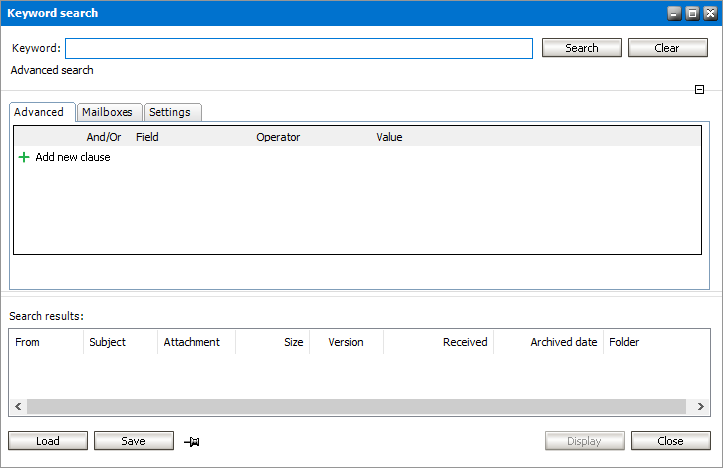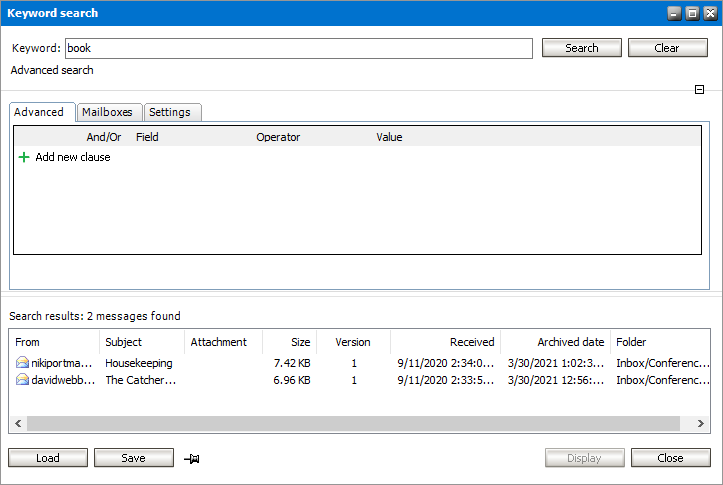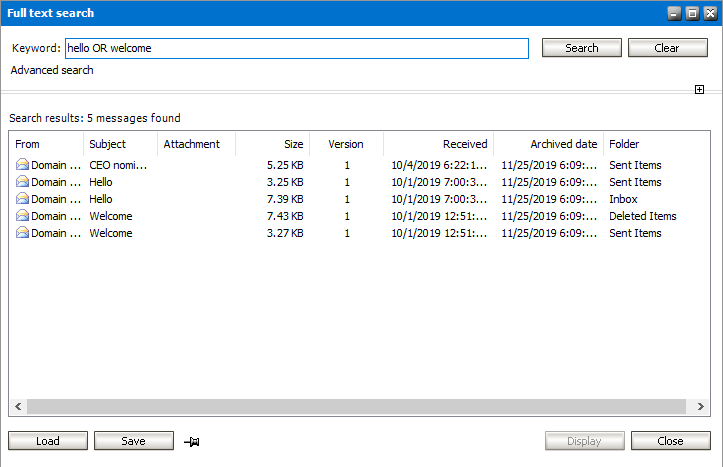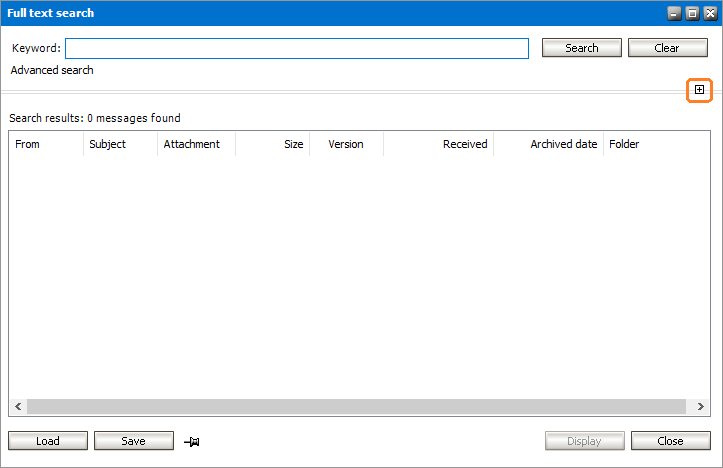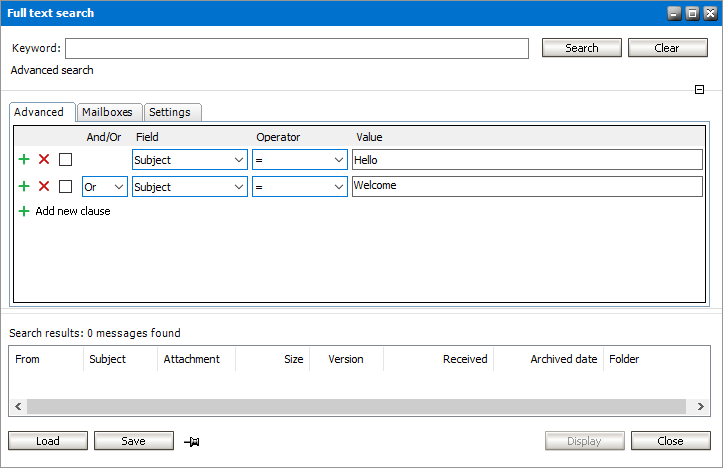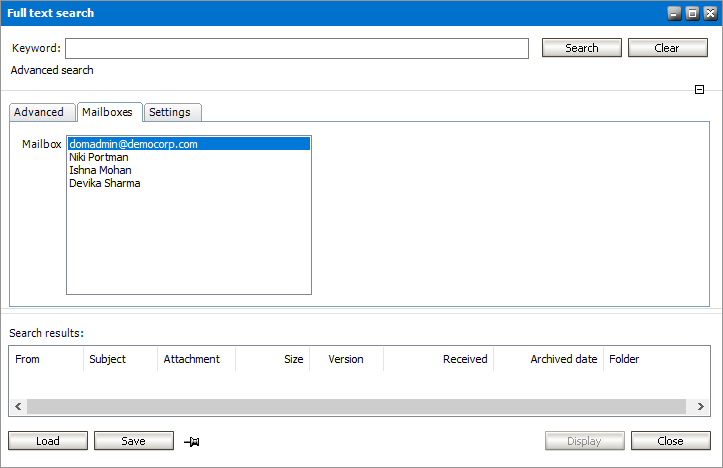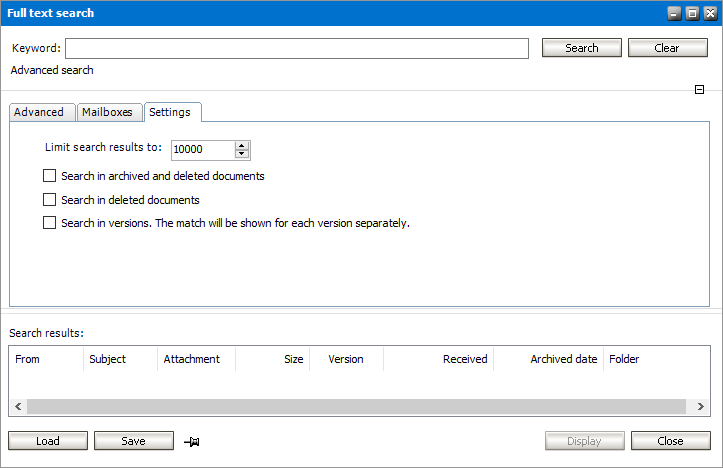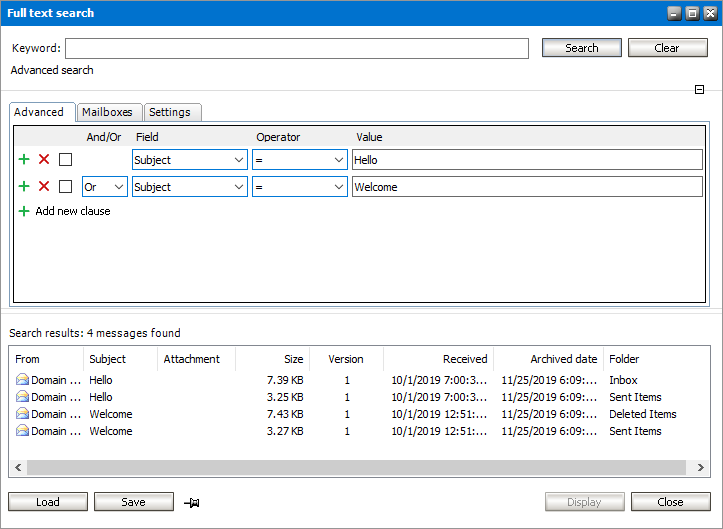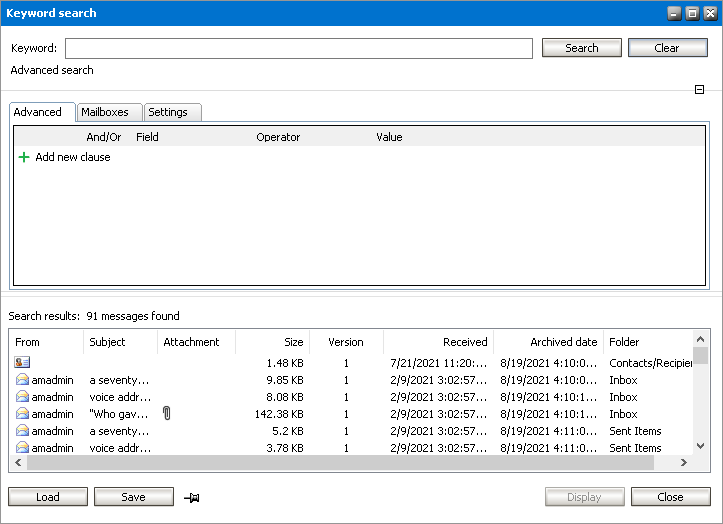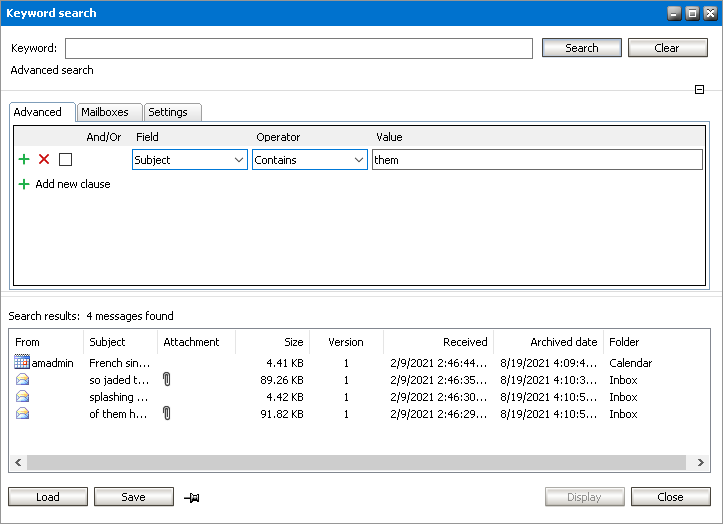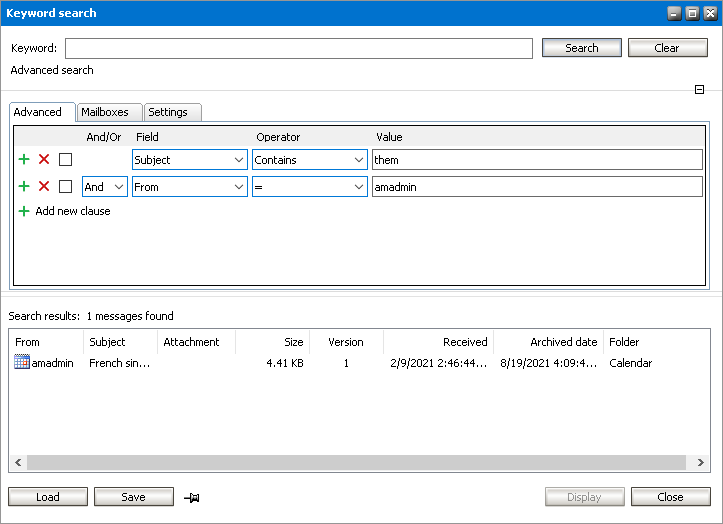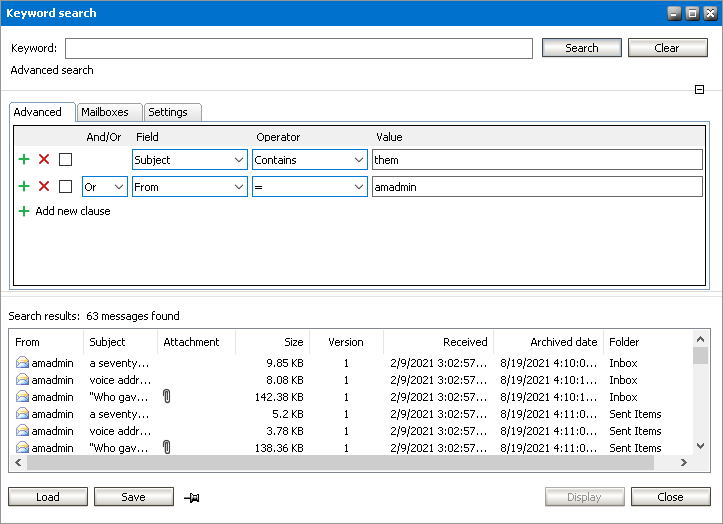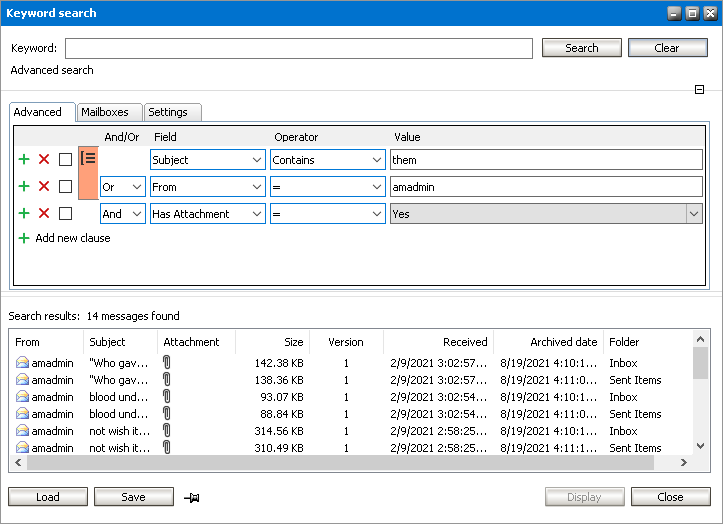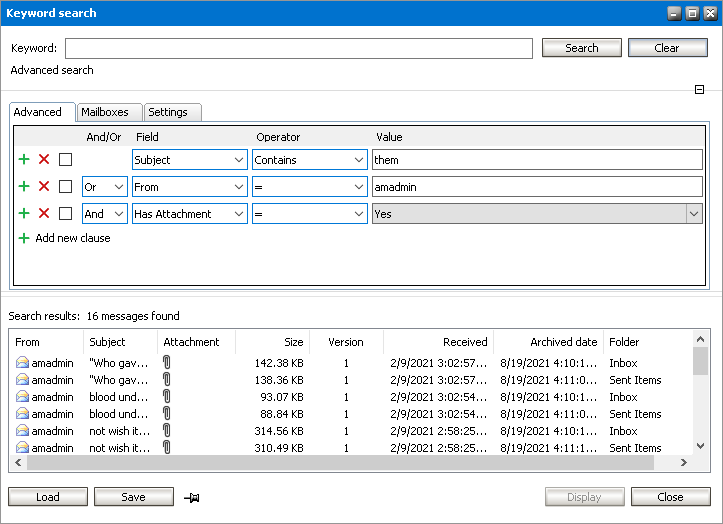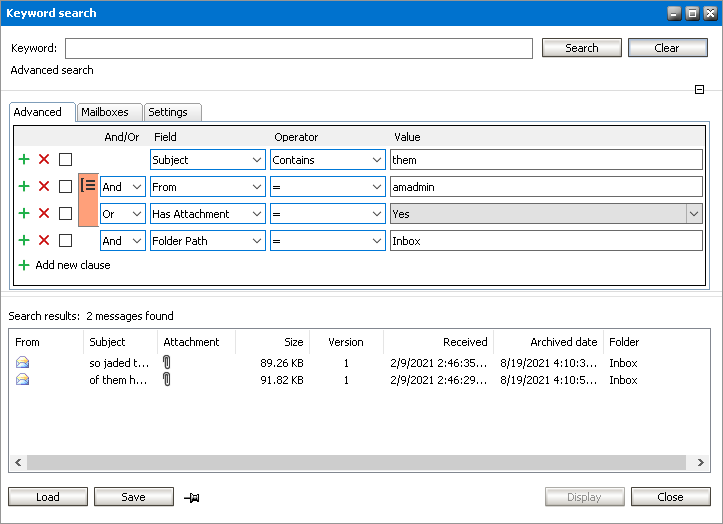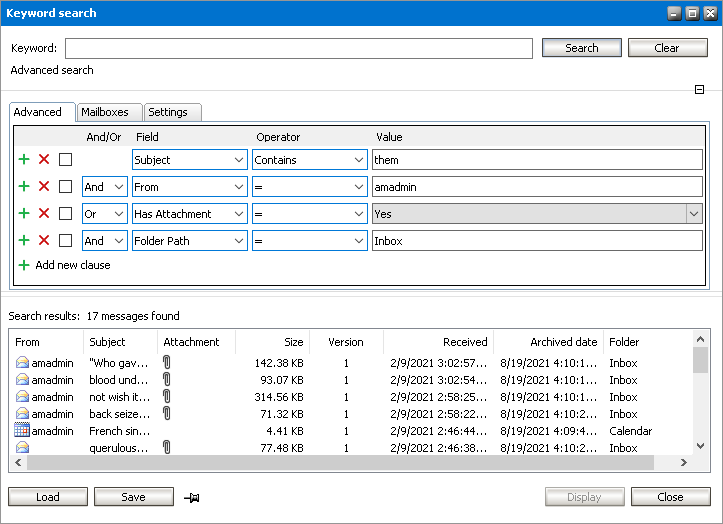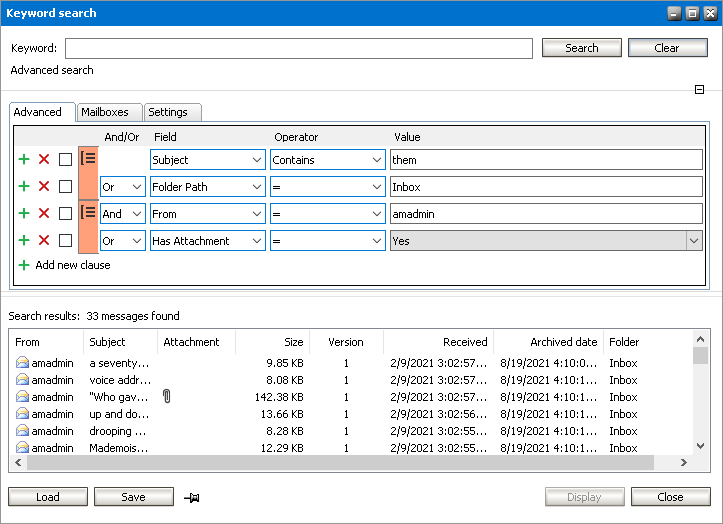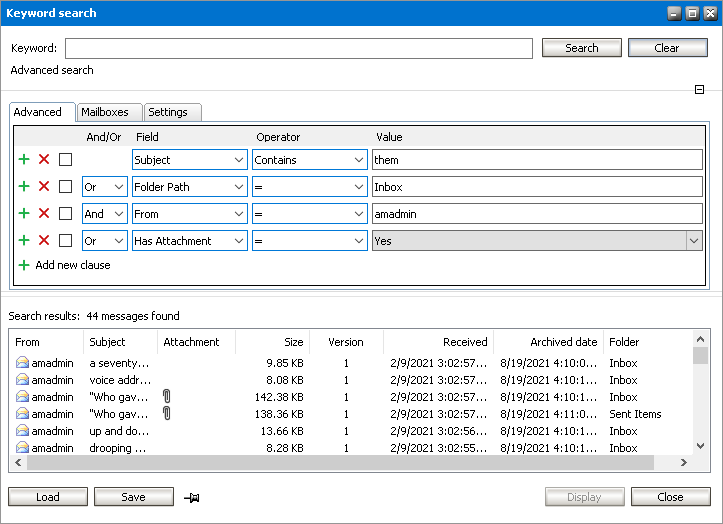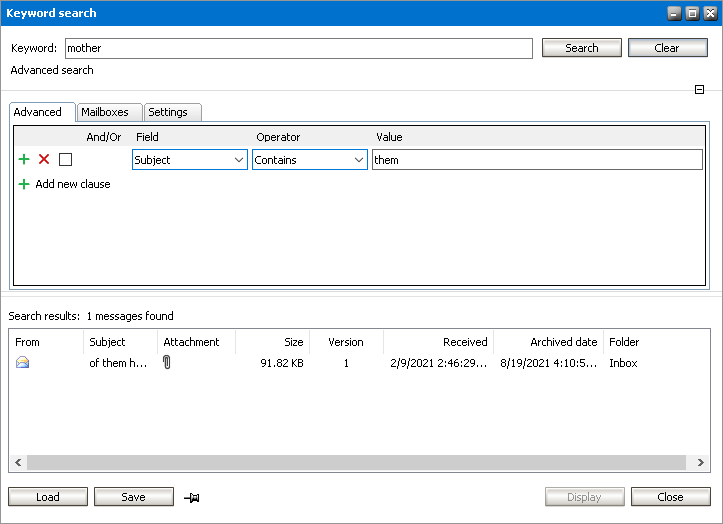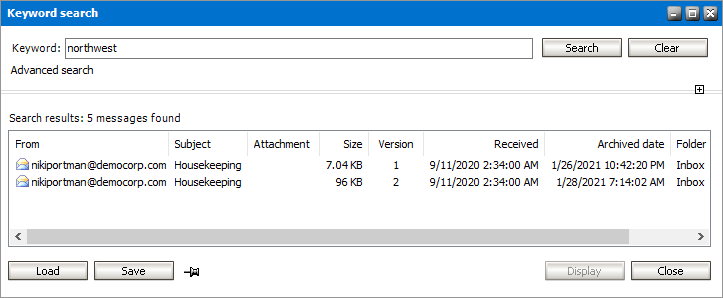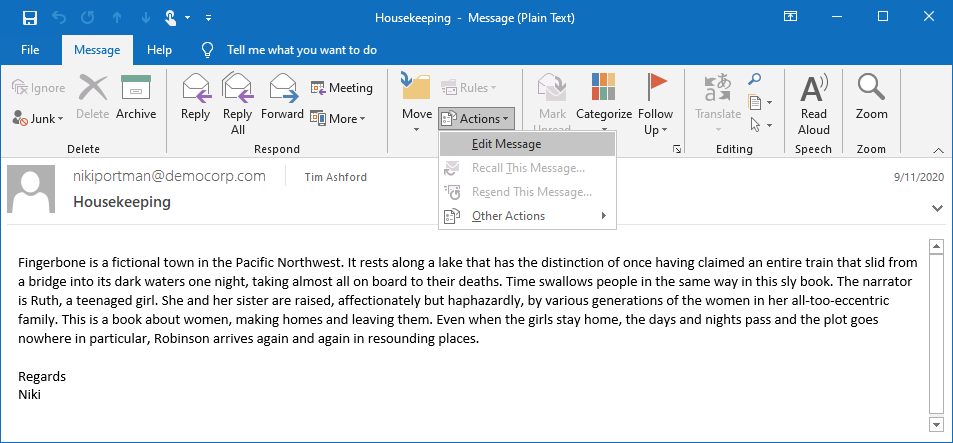Search
In this chapter:
Keyword search is used for searching through archived emails and attachments. It is possible to search for text in pictures (OCR search) although this technology has some limitations. For example, tiny text may not be correctly recognized. Keyword search can be used for searching through archived and subsequently restored mails.
Steps to run a keyword search
1.Click the Archive Manager addin.
2.Click Search from the ribbon.
3.The Search window opens.
4.Enter the keywords in the Search for the word(s) field. The keyword is searched in the subject, email body and attachments.
5.The result of the search is then displayed in the Search results window.
6.From the the Search results window, you can retrieve an archived email by either selecting the email and clicking Display or by double-clicking the email.
Search Expressions
Search expressions are a combination of keywords and logical operators that enhance the search capability. Keywords can be used in combination with the logical operators AND, OR. The operator AND is not mandatory. If no logical operator is included, the keyword search query engine searches for documents containing all the given words.
Example 1:
Search results for hello AND welcome are the same as search results for the string hello welcome or welcome hello. When you intend to look for an exact phrase (a group of words that functions as a single unit in the syntax of a sentence) you should use quotation marks " ".
Example 2:
Archive Manager Search supports other operators: NOT, + and -. Single and multiple character wildcard searches are supported as well:
|
Character |
Description |
Example |
|
? |
single character wildcard; replaces any single character |
te?t matches text, test etc. |
|
* |
multiple character wildcard; replaces 0 or more characters |
test* matches test, tests, tester etc. |
|
+ |
requires that the term after the "+" symbol exist somewhere in a the field of a single document |
+test data searches for documents that must contain "test" and may contain "data" |
|
NOT |
excludes documents that contain the term after NOT. This is equivalent to a difference using sets. The symbol ! can be used in place of the word NOT Note: The NOT operator cannot be used with just one term. For example, the following search will return no results: NOT "test server". |
"test data" NOT "test server" searches for documents that contain "test data" but not "test server" |
|
- |
excludes documents that contain the term after the "-" symbol |
"test data" -"test server" searches for documents that contain "test data" but not "test server" |
|
|
NOTE: The above mentioned wildcard specification characters, i.e. ? or * etc., cannot occur as first 2 characters of the search phrase. The search query as such cannot other contain special characters as ":", "\", "!", "^", "~". |
You can use the Save / Load buttons to save / load search criteria you have specified. It is especially useful e.g. when you have set special settings for Advanced search (see further).
Advance search lets you specify your search criteria in more detail.
Steps to use advanced search
1.Click the plus (+) sign to expand the advanced search section.
2.Click the Advanced tab.
3.Click Add new clause and enter the search criteria using the fields as described below:
a.Field - click the drop down to select the property of the email to be searched. For example, select Subject as the field to search.
b.Operator - click the drop down and select a search operator.
c.Value - Specify the search text. If the selected Field requires a date value, a date picker icon appears to help you choose a date. This field supports wildcard characters.
4.To add more criteria clauses, click Add new clause or 

|
|
NOTE: You can group clauses to create nested search criteria by selecting consecutive check boxes and clicking the |
5.To view the scope of the search on mailboxes, click the Mailboxes tab. By default only the current mailbox is added. You must select more mailboxes manually if you want to search additional mailboxes.
|
|
NOTE: If you do not see additional mailboxes, the Administrator must follow the steps below to expand the search scope to more mailboxes: a.Open the Address Book Manager in the Archive Manager for Exchange Administration Center (AMAC). b.Click Mailboxes to open the list of mailboxes. c.Right-click the mailbox you want to add and select Permissions from the context menu. The Mailbox rights window opens. d.Click Add and select the Outlook user who will run the search. Then click OK to close the windows. e.Open the Advanced search window again and click the Mailboxes tab to view the additional mailboxes |
6.To set the search scope on email item types, click the Settings tab.
Configure the settings as described below:
a.Limit search results to - the number of emails that are returned in the search result list.
b.Search options allow you to specify the category of documents to search.
·No selection - only archived documents are searched. Previous versions of these documents are not included.
Select one of the following options:
·Search in archived and deleted documents - all documents will be searched. Previous versions of these documents are not included.
·Search in deleted documents - deleted documents and documents that are marked for deletion will be searched. All other archived documents will be ignored. Previous versions of these documents are not included.
Add an additional criteria:
·Search in versions - Previous versions will be included for the document category specified. The match will be shown for each version separately..
7.Click Search to search for archived emails based on the selection criteria, the mailboxes specified and the settings that are applied.
8.Click Save to save the search criteria as an XML file. The saved search criteria does not include the list of mailboxes used in the search scope. Click Load to load a previously save search criteria.
How to build search queries
This topic describes how to build search conditions using the advanced search capabilities of Archive Manager for Exchange. A search condition (or query) can contain zero or more search clauses that are combined using operators and grouping of search clauses.
In this topic:
A simple search conditions needs no search clause or can contain just one search clause.
Example 1
Click Search without adding a search clause. In this case, you will get back all the archived items.
Example 2
Add a single search clause with a condition where the field Subject contains the word "them. When you click Search, you will get back all the archived items where the Subject contains the word "them".
The AND/OR operator is used between two search clauses. With these operators, you can combine two or more search clauses. The AND operator will return a search result if both the search clauses separated by the AND operator are fulfilled. The OR operator will return a search result if any one of the search clauses separated by the OR operator are fulfilled. The AND operator has a higher priority over the OR operator. When a search condition contains both the AND and OR operators, the search clauses that are combined with the AND operator must be fulfilled first.
Example 1
To find all items where the Subject contains word "them" AND the Sender is "amadmin", you must combine two search clauses as shown:
Example 2
To find all items where the Subject contains word "them" OR the Sender is "amadmin", you must combine two search clauses as shown:
Sometimes simple combinations of search clauses with the AND and OR operators are not enough. Grouping is a good solution to change the priority between the operators. The grouped search clauses have a higher priority than the operator before or after the group. The examples in this section describe how the grouping works.
Example 1
To find all items where the Subject contains the word "them" AND the Sender is "amadmin", and all these items must also have an attachment then the search condition is as shown:
Query: (Subject contains "them OR Sender is "amadmin") AND has attachment
We can split this search condition into two parts
1. (Subject contains "them OR Sender is "amadmin) which is a group
2. AND has attachment
Since a grouping has a higher priority, the search condition in the group must be fulfilled first. In this case each item in the search result will have a Subject that contains the word "them AND the Sender is "amadmin, and the item will also have an attachment
Example 2
To find all items where the Subject contains word "them or, the Sender is "amadmin and at the item must have an attachment, then the query is as shown:
Query: Subject contains "them OR Sender "admin AND has attachment
This query can be split into two parts
1. Subject contains "them OR
2. Sender is "amadmin AND the item has an attachment
The AND operator has a higher priority so the search clauses combined with the AND operator must be fulfilled first. In this case the search result will contain items where the item must have an attachment and the Sender must be "amadmin, or Subject should contain the word "them.
Example 3
To find all items where the Subject contains the word "them" and the Sender is "amadmin, or the item has attachment, and the item must be in the "Inbox" folder then the search condition is as shown:
Query: Subject contains "them AND (Sender is "amadmin" OR has attachment) AND Folder path is "Inbox"
This query can be split into three parts
1. Subject contains "them AND
2. (Sender is "amadmin OR the item has an attachment)
3. AND Folder path is "Inbox
The grouped search clauses have the higher priority in this query so the search condition in the group must be fulfilled first. In this case the search result will contain items where the Subject must contain the word "them + Sender should be "amadmin or the item has an attachment + the folder path must be "Inbox.
Example 4
To find all items where the Subject contains the word "them and Sender is "amadmin, or the item has an attachment and these items should be in the "Inbox folder then the search query is as shown:
Query: Subject contains "them" AND Sender is "amadmin" OR has attachment AND Folder path is "Inbox"
This query can be split into two parts
1. Subject contains "them AND Sender is "amadmin OR
2. Item has attachment AND Folder path is "Inbox
The AND operator has a higher priority in this query so the conditions with the AND operators must be fulfilled first. In this case the search result will contain all items where Subject contains the word "them" and Sender is "amadmin" or the item must have an attachment and the folder path must be "Inbox".
Example 5
To find all items where the Subject contains word "them or these items are in the "Inbox folder, and the Sender is "amadmin or the item has an attachment, then the query is as shown:
Query: (Subject contains "them OR Folder path is "Inbox") AND (Sender is "amadmin" OR has attachment)
This query can be split into two parts
1. (Subject contains "them" OR Folder path is "Inbox") AND
2. (Sender is "amadmin" OR item has attachment)
The grouped condition has the higher priority in this query so the conditions in the group must be fulfilled first. In this case the search result will contain items where Subject should contain "them word or folder path should be "Inbox + Sender should be "amadmin or the item should have an attachment.
Example 6
To find all items where the Subject contains the word "them" or, these items are in the "Inbox folder and the Sender is "amadmin", or the item has an attachment, then query is as shown:
Query: Subject contains "them OR Folder path Inbox AND Sender is "amadmin OR item has an attachment
This query can be split into three parts
1. Subject contains "them OR
2. Folder path is "Inbox" AND Sender is "amadmin"
3. OR item has an attachment
The AND operator has a higher priority so the conditions with the AND operator must be fulfilled first. In this case the search result will contain items where Subject must contain the word "them or folder path must be "Inbox and Sender must be "amadmin or the item has an attachment.
Keyword search provides a fast and flexible search for keywords in the email Subject, body, and attachments of messages in Metalogix Archive Manager for Exchange. If you leave this field empty, then the search result will show all archived messages. If you enter a word or phrase in the keyword field and click Search the result of the search will show all the archived messages where the Subject, body or attachment contains the entered word or phrase.
Example 1
You can combine keyword searches with advanced search clauses to find specific messages. Keyword searches are combined with advanced search conditions with the AND operator. The search result will contain items that have the keyword and the advanced search conditions as well. To find all messages where the Subject, body or attachment contains word "mother" and the Subject also contains the word "them", the search query is as shown:
The body of the message contains word "mother", and the Subject contains word "them"
Versions
Each time you retrieve and edit an archived email a new version of that email is created in the HSM Store. Versions are also created automatically when Archive Manager is configured to create a delayed shortcut. For example if you have an email that is archived with a delayed shortcut, the original email is still available in you mailbox even though it is marked to be archived. If you edit and save this this email and it is eventually archived, a new version of the email will be created.
Different versions of an archived email can be checked in the Versions window.
Steps to work with the Versions window
1.Click the Archive Manager addin.
2.Select an archived email and click Versions from the ribbon.
3.If the archived email has versions, then all the versions will be displayed in the list.
The actions you can perform in the Versions window are described below:
a.Display - opens the selected version of the archived email.
b.Create new copy - creates a new email based on the selected version. This newly created email is not archived and you must archive it manually.
c.Restore - restores the selected version. The restored version of email will be retrieved and deleted from the archive.
d.

|
|
NOTE: ·You can click any column header to sort the list based on the header. ·The keyword search engine searches for keywords in every version of the archived emails. Search results may contain more than one version of the same email. |
Steps to create a new version of an archived email
1.Open Outlook.
2.Double-click an archived email to retrieve and open the email in the Outlook message editor.
3.From the Message ribbon select Actions > Edit Message.
4.Revise the message as needed and save the message.
5.Click the Archive Manager addin.
4.Select the edited archived email and click Versions from the ribbon to verify that a new version was created and successfully archived.
Offline synchronization
Working with archived emails is possible even when you use your MS Exchange Server mailbox offline. Before switching to offline mode you must synchronize your Outlook mailbox with the MS Exchange Server. If you also plan to work with your archived emails you must synchronize with the Archive Manager addin as well. For automatic synchronization see Offline options.
Steps to synchronize archived emails for offline use
1.Run Outlook synchronization.
2.Click the Archive Manager addin.
3.Click Offline Folder Synchronization.
4.When you reconnect wit MS Exchange Server online, you must synchronize your Outlook mailbox with the MS Exchange Server. Then you must synchronize your Outlook mailbox with the Archive Manager Server as well to update your Outlook mailbox with the current state of all archived messages from the MS Exchange Server.


